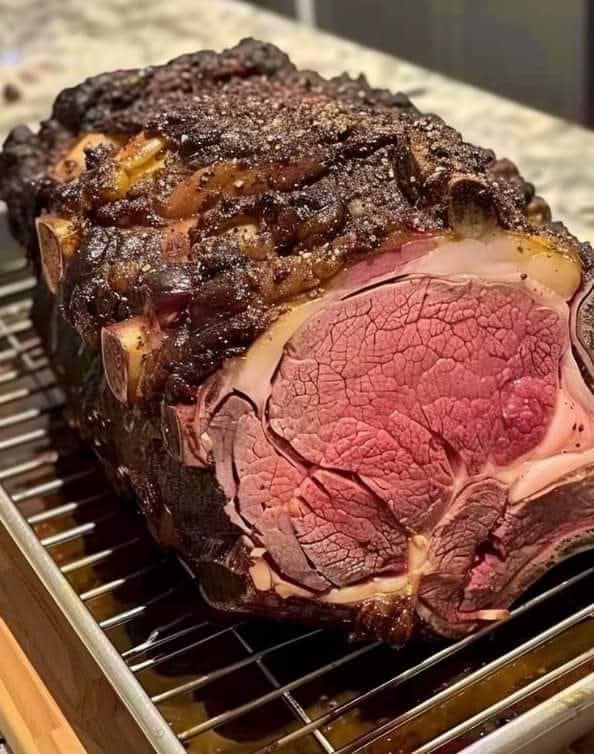News
Prime Rib Recipe

Prime rib, also known as a standing rib roast, is a flavorful and tender cut of beef often served for special occasions, holidays, or family gatherings. With a rich, juicy texture and a crispy, flavorful crust, it’s a dish that’s sure to impress any crowd. The key to a perfect prime rib lies in seasoning, cooking it to the ideal temperature, and allowing it to rest so the juices redistribute for the most tender roast possible.
Ingredients:
1 (4 to 6-pound) bone-in prime rib roast
3 tablespoons olive oil or melted butter
4 garlic cloves, minced
2 tablespoons fresh rosemary, finely chopped (or 2 teaspoons dried)
2 tablespoons fresh thyme, finely chopped (or 2 teaspoons dried)
2 teaspoons kosher salt
1 teaspoon freshly ground black pepper
1 teaspoon onion powder (optional)
1 teaspoon Dijon mustard (optional, for extra flavor)
Instructions:
Preheat the oven:
Preheat your oven to 500°F (260°C).
Prepare the roast:
Pat the prime rib roast dry with paper towels to remove excess moisture.
This will help achieve a nice crust.
Season the roast:
In a small bowl, combine olive oil (or melted butter), minced garlic, rosemary, thyme, kosher salt, black pepper, and optional onion powder and Dijon mustard.
Rub the seasoning mixture all over the surface of the roast, making sure to coat all sides generously.
Roast the prime rib:
Place the roast bone-side down (fat-side up) on a roasting pan or baking dish.
Insert a meat thermometer into the center of the roast, ensuring it doesn’t touch the bone.
Initial high-heat roasting:
Roast the prime rib at 500°F for about 15 minutes to create a crust.
Lower the temperature: After 15 minutes, reduce the oven temperature to 325°F (165°C). Continue roasting for about 1.5 to 2 hours (or until the internal temperature reaches your desired level of doneness, e.g., 125°F for rare, 135°F for medium-rare, or 145°F for medium).
Rest the roast:
Once done, remove the roast from the oven and let it rest for 15-20 minutes. This helps the juices redistribute, ensuring a juicy and tender roast.
Carve and serve:
Slice the roast against the grain, ensuring even portions. Serve immediately with your favorite side dishes.
Description:
Prime rib is a classic, indulgent dish often enjoyed at holidays or gatherings.
Its tender, juicy meat and savory, herb-seasoned crust make it a standout centerpiece on the dinner table.
The initial high-heat roasting creates a deliciously caramelized exterior, while the slow, lower-temperature cooking ensures a perfectly cooked interior, from edge to center. Paired with horseradish sauce, mashed potatoes, or roasted vegetables, it’s a meal that everyone will remember.
Tips:
Room temperature roast: Let the prime rib come to room temperature for about 1-2 hours before roasting.
This helps ensure even cooking.
Use a meat thermometer:
This is the best way to ensure your roast reaches the desired doneness.
Overcooking can result in a dry roast, so avoid guessing the time.
Resting is key:
Never skip the resting step. It allows the juices to redistribute, making the roast tender and juicy.
Searing options:
If you prefer a more intense crust, you can sear the roast on the stovetop in a hot skillet before placing it in the oven.
Corrections/Variations:
If you don’t have fresh herbs, dried versions can work, but use about one-third of the quantity called for in the recipe.
For a different flavor profile, try adding spices like smoked paprika, cumin, or garlic powder to the seasoning mix.
If you prefer a richer crust, you can rub the roast with Dijon mustard before applying the seasoning mix. This will help the herbs and spices stick better and add flavor.
If cooking a larger or smaller roast, adjust the cooking time accordingly. A 2-pound roast will take less time, while an 8-pound roast may take longer, so always rely on a meat thermometer to check for doneness.
